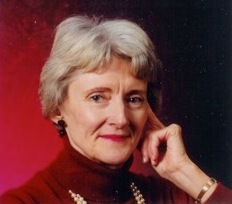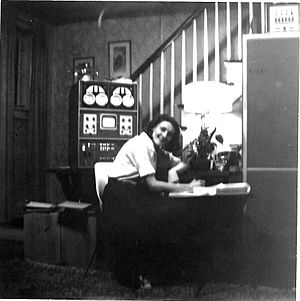Mary Allen Wilkes facts for kids
Quick facts for kids
Mary Allen Wilkes
|
|
|---|---|
 |
|
| Born | September 25, 1937 (age 88) Chicago, Illinois, U.S.
|
| Alma mater | Wellesley College, Harvard Law School |
| Known for | Work with LINC computer |
| Scientific career | |
| Fields | Computer programming, logic design, law |
| Institutions | MIT, Washington University in St. Louis |
Mary Allen Wilkes (born September 25, 1937) is a talented American who worked as a computer programmer and designer. She later became a lawyer. Mary Allen Wilkes is famous for her important work with the LINC computer. Many people now see the LINC as the world's first personal computer (PC).
Contents
Early Life and Career
Mary Allen Wilkes was born in Chicago, Illinois. She went to Wellesley College and finished her studies in 1959. There, she focused on philosophy and theology. Mary first wanted to become a lawyer. However, her friends and teachers told her it would be very hard for women in that field.
A geography teacher once told her she should be a computer programmer. Mary decided to try it and became one of the first computer programmers. She worked in this field for many years. Later, in 1975, she did go to law school and became a successful attorney.
Working at MIT
From 1959 to 1960, Mary Allen Wilkes worked at MIT's Lincoln Laboratory. She was part of the Speech Recognition Project. Her job was to program large computers like the IBM 704 and the IBM 709.
In 1961, she joined the Digital Computer Group at Lincoln Laboratory. This group was just starting to design the LINC computer. The LINC was being created by Wesley A. Clark, who had designed other computers before. Mary helped with the LINC in many ways. She simulated how the LINC would work before it was built. She also designed the control panel for the first LINC model. Plus, she wrote the instructions for how to use the final LINC computer.
In 1963, the LINC team moved to MIT's campus in Cambridge, Massachusetts. They started a new center there. In the summer of 1963, they began training people to use the LINC. Mary taught these training programs. She also wrote the first programming tools for the LINC, called LAP (LINC Assembly Programs). She even helped write the LINC's main programming manual.
Developing the LINC at Home
In 1964, some of the LINC team members left MIT. They formed the Computer Systems Laboratory at Washington University in St. Louis. Mary Allen Wilkes rejoined this group in late 1964. However, she worked from her parents' home in Baltimore until late 1965.
The Computer Systems Laboratory sent a LINC computer to her home. This meant Mary Allen Wilkes was likely the first person to use a personal computer in a private home.
By 1965, the LINC team had made the computer's memory bigger. This allowed Mary to create a more advanced operating system called LAP6. LAP6 was very user-friendly. It let people easily create, change, and organize documents, usually LINC programs. Users could do this in real-time using the LINC's keyboard and screen. This was much like how we use personal computers today.
The LINC used special tapes to store information. These tapes worked like a scroll, letting users move through their work. They also helped organize files and programs. Programs could be turned into code the computer understood and then run. Users could even add their own programs to LAP6. They could also share programs by swapping the small LINC tapes. This was an early example of "open source" sharing.
Mary Allen Wilkes was asked if she was the first person to use a computer at home. She replied, "Well, I guess I might have been..."
After the LINC, the Computer Systems Laboratory worked on "Macromodules." These were like building blocks for computers. Mary designed the most complex of these blocks, called the multiply macromodule.
Law Career and Later Work
Mary Allen Wilkes left the computer field in 1972. She went to Harvard Law School to become a lawyer. For many years, she worked as a trial lawyer. She worked in private law firms and also led a division that fought economic crimes and protected consumers in Massachusetts.
From 1983 to 2011, she taught law students at Harvard Law School. She also served as a judge for student law competitions for 18 years. In 2001, she became an arbitrator for the American Arbitration Association. This meant she helped settle disagreements, especially those about computer science and technology. From 2005 to 2012, she was a judge for an international law competition in Vienna, Austria.
Why Mary Allen Wilkes is Important
Mary Allen Wilkes is recognized in the world of computer science for several key reasons:
- She designed LAP6, an interactive operating system for the LINC. This was one of the first systems like it for a personal computer.
- She is considered the first person to use a personal computer in a private home.
Her work has been celebrated in different exhibitions. In 2013, Great Britain's National Museum of Computing at Bletchley Park featured her in their "Heroines of Computing" exhibition. The Heinz Nixdorf Museums Forum in Paderborn, Germany, also recognized her in their 2015-2016 exhibition, "In the beginning was Ada: Women in Computer History."
Famous Quotes
Mary Allen Wilkes is known for some memorable quotes:
- "I'll bet you don't have a computer in your living room."
- "We had the quaint notion at the time that software should be completely, absolutely free of bugs. Unfortunately it's a notion that never really quite caught on."
Selected Writings
Mary Allen Wilkes wrote several important papers and manuals:
- "LAP5: LINC Assembly Program", a paper from 1966.
- LAP6 Handbook, a guide published in 1967.
- Programming the Linc, a programming manual she co-wrote in 1969.
- "Conversational Access to a 2048-word Machine", an article from 1970 describing LAP6.
- "Scroll Editing: an on-line algorithm for manipulating long character strings", a paper from 1970 about her editing technique.
See also
 In Spanish: Mary Allen Wilkes para niños
In Spanish: Mary Allen Wilkes para niños


